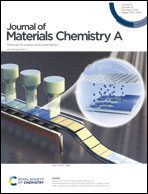P3-Type K0.45Co1/12Mg1/12Mn5/6O2 as a superior cathode material for potassium-ion batteries with high structural reversibility ensured by Co–Mg Co-substitution†
Abstract
Mn-based layered oxides, as potential cathodes for potassium-ion batteries (PIBs), face major challenges such as consecutive phase transition, serious capacity loss, and sluggish K+ transport kinetics. Herein, Co–Mg co-substituted K0.45Co1/12Mg1/12Mn5/6O2 is designed as a promising cathode material for PIBs to conquer the above issues in this work. Co3+–Mg2+ ions occupying the Mn3+ sites are confirmed to effectively alleviate the Jahn–Teller distortion induced by Mn3+ ions. P3-K0.45Co1/12Mg1/12Mn5/6O2 exhibits highly reversible single-phase structural evolution during the K+ deintercalation/intercalation. In contrast, the pristine K0.45MnO2 electrode experiences incompletely reversible structural variation from a P′3 to P3 phase. The increase of structural stability in the Co–Mg co-substituted sample is the main reason leading to improved cycling stability. Moreover, K0.45Co1/12Mg1/12Mn5/6O2 delivers better rate capability resulting from faster K+ diffusion compared to K0.45MnO2. Therefore, Co–Mg co-substitution is an effective strategy to enhance the structural stability and electrochemical properties of Mn-based layered oxides in PIBs.


 Please wait while we load your content...
Please wait while we load your content...